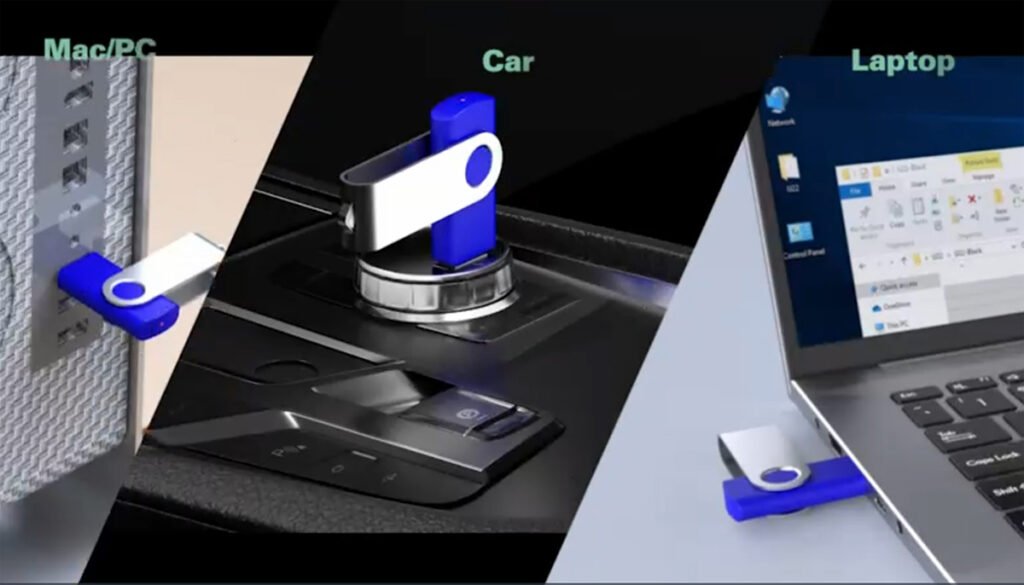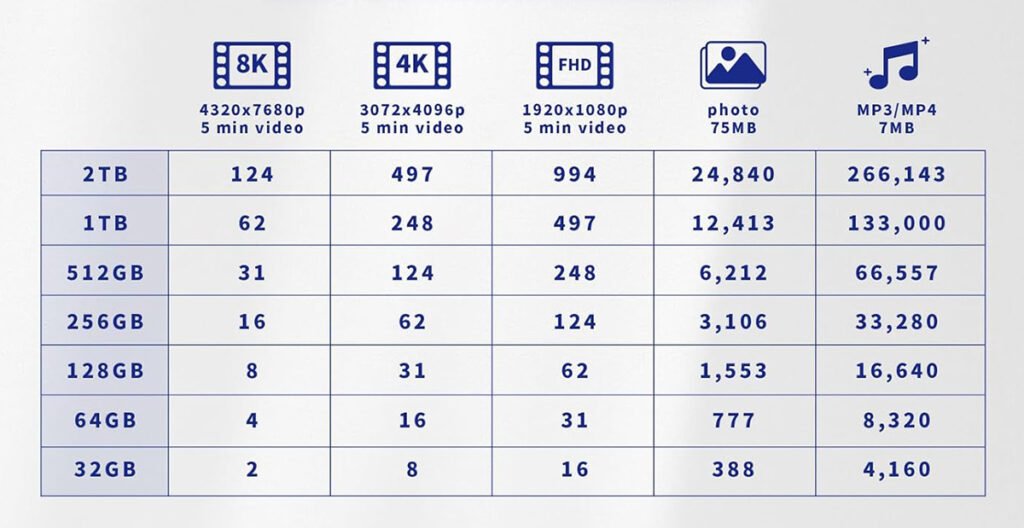USB flash drives come in a wide range of capacities, from ultra-small sizes of just tens of megabytes to massive capacities of 2TB. The most commonly chosen capacities are 1GB, 2GB, 4GB, 8GB, 16GB, 32GB, and 64GB. Currently, 32GB and 64GB are the mainstream capacities.
With the rise of USB 3.0 interfaces, many customers are now opting for ultra-high capacities as well. Below, we provide a detailed breakdown of USB flash drive capacities:
1. Small-capacity
1GB: This capacity USB drive is smaller than 4GB and has nearly disappeared from the consumer market.
Its storage space can only hold a few dozen to a hundred simple Word documents or a small number of low-resolution images. It cannot even store standard-definition videos, making it extremely impractical for daily use. Its cost-effectiveness is far inferior to drives with 4GB or higher capacities.
2GB:Slightly larger than 1GB, but still a niche, uncommon capacity with very limited availability.
It can store hundreds of office documents, several hundred standard small images, or one small software installation package (like a basic office tool). It’s only suitable for temporarily transferring very small amounts of files to extremely outdated devices.
4GB: This capacity is rarely chosen for daily storage today, with limited availability.
It can hold several hundred Word documents, over a thousand standard JPG images, or be used to create a basic Windows PE boot disk. Suitable for temporary small file transfers, but offers low cost-effectiveness.
8GB: Slightly more practical than 4GB
it can store more office documents and photos, plus 1-2 standard-definition short videos (approx. 4GB each) or a single office software installation package. It remains best suited for temporary use, such as carrying a small amount of data during short business trips, and meets basic office needs.

2. Standard-Capacity(Most Popular Choice)
- 16GB: The entry-level mainstream capacity, ideal for students and light office users. It easily stores thousands of assignments, course materials, or office documents, holds several thousand standard photos, and even fits one standard-definition movie—meeting basic file transfer and storage needs.
- 32GB: More practical than 16GB, this is a popular choice for those who prioritize sufficiency. It can hold thousands of lossless music tracks (approx. 30MB per track), 4-5 standard-definition videos, and multiple office software or small tool installation packages, ensuring ample space for daily work and study.
- 64GB: One of the most popular choices, balancing capacity and portability. Easily stores 1-2 1080p HD videos (approx. 20-30GB each), plus numerous photos and a full set of office documents. Ideal for daily file transfers or as a temporary backup for phones and cameras.
- 128GB: The “all-purpose” option among standard capacities, covering most daily and light professional needs. It can store multiple HD videos, numerous PSD/AI design files, and even portable office software or small games. Paired with a USB 3.0 or higher port, transfer speeds are also guaranteed.

3.Large Capacity (Suitable for Professional Settings)
- 256GB: Ideal for users with moderate to high capacity needs, such as designers and content creators. It can store 4-5 4K short videos (approx. 50GB each), a full backup of office documents, or serve as extended storage for laptops to hold large software installers or virtual machine images.
- 512GB: Approaching the capacity of a compact portable hard drive, this option suits users requiring extra storage “buffer.” It easily handles massive RAW photo collections (approx. 20-50MB per photo), multiple 4K HD videos, and complete backups of all mobile/tablet data (including apps, caches, and files) without frequent cleanup.
- 1TB: Capacity rivals mainstream portable hard drives, primarily targeting professional users like photographers and video editors for storing massive shooting materials or ultra-long 4K videos. It can also serve as an offline backup drive for home or small offices, though it comes at a higher price and may not be recognized by some older devices.
- 2TB: Represents ultra-high capacity, suitable only for specialized professional needs. It can store large quantities of ultra-high-definition videos, massive project files, or server data backups. Its size is typically slightly larger than a standard USB drive. Before purchasing, ensure your devices (computers, cameras, etc.) support such large capacities.

4. Special Capacity(Ultra-Low Capacity)
Special capacities primarily refer to USB drives with storage sizes in the tens or hundreds of megabytes, such as 32MB, 64MB, 128MB, and 512MB. These drives are older, legacy models that are rarely sold in consumer markets today.
They are primarily used in certain outdated industrial equipment or specialized instruments. Their limited storage makes them inadequate for everyday document storage, serving instead for specific purposes like storing electronic manuals for machinery.
Table of USB Drive Capacities
| Capacity | Suitable Users / Uses |
|---|---|
| 32MB, 64MB, 128MB, 512MB | Old industrial equipment, specialized instruments |
| 1GB | PPT documents, conference document display, daily office work |
| 2GB | Daily office files, offline data, photos |
| 4GB | Temporary storage of simple documents |
| 8GB | Temporary storage of standard-definition videos |
| 16GB | Students, light office workers; storage of assignments |
| 32GB | Office workers, daily users; storage of music |
| 64GB | General users; storage of high-definition videos |
| 128GB | Daily + light professional users; storage of design files |
| 256GB | Designers, self-media professionals; storage of 4K videos |
| 512GB | Users with redundant capacity needs; storage of a large number of RAW photos |
| 1TB | Photographers, editors; storage of a large number of materials |
| 2TB | Professional users; storage of ultra-high-definition videos |
In summary, for basic file storage, 4GB to 32GB is sufficient. For everyday office use and storing high-definition videos, 64GB to 128GB offers the best practicality and value for money. Only consider capacities above 256GB if you need to handle large amounts of professional content like 4K videos or design files. Ultra-small capacity flash drives are primarily for niche needs—skip them otherwise. Choosing based on your actual requirements will prevent waste.



